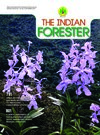Avenue Tree Health Survey of Forest Research Institute, Dehradun
DOI:
https://doi.org/10.36808/if/2018/v144i9/132677Keywords:
Disease Incidence, Disease Severity, Risk Factor, Severity Index.Abstract
Avenue trees are ornamental, shade giving, aesthetically soothing and may also be medicinally important. Therefore, knowledge of status of tree health in a given area is a pre-requisite in evolving a disease management strategy for the region. Individual trees of the selected roads in the FRI campus were examined for signs and symptoms of different diseases. Tree diseases and their occurrence were calculated. A total of 853 trees were surveyed. 52% trees were diseased which include both exotic and native tree species. It was recorded that trees with girth 150-432 cm were found to be highly affected with pathogenic attack. Decaying trees bearing fruit bodies of pathogens and anthropogenic activities were responsible for disease prevalence. Suitable management strategies have been suggested to address the disease problems on the avenue trees in the FRI campus.References
Bhambani K. and Harsh N.S.K. (2012). Assessment of tree health along Trevor road, New forest area, Dehradun. Lap Lambert Academic Publishing GmbH & Company KG + 92 pp.
Foster J., Lowe A. and Winkelman S. (2011). The Value of Green Infrastructure for Urban Climate Adaptation. The Center for Clean Air Policy + 52 pp. (http://ccap.org/assets/The-Value-of-GreenInfrastructure-for-Urban-Climate-Adaptation_CCAP-Feb2011.pdf)
Jim C.Y. and Chen W.Y. (2008). Assessing the ecosystem service of air pollutant Removal by urban trees in Guangzhou (China). J. Envir. Management, 88(4): 665-676.
Lovasi G.S., Quinn J.W., Neckerman K.M., Perzanowski M.S. and Rundle A. ( 2008). Children living in areas with more street trees have lower prevalence of Asthma. J. Epidemiology and Community Health, 62(7):647-649.
McPherson, Greg E., Simpson, J.R. Peper, Maco S.E. and Xiao Q. (2005a). Municipal Forest Benefits and Costs in Five U.S. Cities. J. Forestry, 103: 411-16.
McPherson, Gregory E., James R. Simpson, Peper P., Maco S.E., Gardner S.L., Cozad S.L., and Xiao Q. (2005b). City of Minneapolis, Minnesota Municipal Tree Resource Analysis. Tech. Center for Urban Forest Research, Pacific Southwest Research Station, USDA Forest Service + 45 pp.
McPherson, Gregory E., Simpson, Peper J.R., Gardner S.L., Vargas K.E. and Xiao Q. (2007). Northeast Community Tree Guide: Benefits, Costs, and Strategic Planting. Tech. USDA, Forest Service, Pacific Southwest Research Station + 106 pp. https://www.fs.fed.us/psw/publications/documents/psw_gtr202/ps w_gtr202.pdf
McPherson, Gregory, Simpson J., Peper P., Gardner S., Vargas K., Maco S. and Xiao Q. (2006). Coastal Plain Community Tree Guide: Benefits, Costs, and Strategic Planting. USDA, Forest Service, Pacific Southwest Research Station + 100 pp. https://www.fs.fed.us/psw/publications/documents/psw_gtr201/ps w_gtr201guide.pdf
Norris M. (2007). Tree Risk Assessments: What Works - What Does Not - Can We Tell? In: ISAAC Conference Perth, 1st May 2007, 31pp.
Nowak D.J., Crane D.E. and Stevens J.C. (2006). Air pollution removal by urban trees and shrubs in the United States. Urban Forestry and Urban Greening, 4(3-4):115-123
Nowak D.J., Crane D.E., Stevens J.C. and Ibarra M. (2002). Brooklyn's Urban Forest. General Technical Report. USDA Forest Service + 112 pp.
Nowak D.J., Hoehn R. and Crane D.E. (2007). Oxygen production by urban trees in the United States. Arboriculture and Urban Forestry, 33(3): 220-226.
Peper P.J., Mcpherson G., Simpson J., Gardner S., Vargas K. and Xiao Q. (2007). New York City, New York Municipal Forest Resource Analysis. Center for Urban Forest Rresearch, Usda Forest Service, Pacific Southwest Research Station + 71 pp.
Sharma J.K. and Shankaran K.V. (1988). Incidence and severity of Botryodiplodia Dieback in Plantations of Albizia falcataria in Kerala, India. Forest Ecology and Management, 24: 43-58.
Simpson J.R. and McPherson E.G. (1996). Potential of tree shade for reducing residential energy use in California. J. Arboriculture, 22(1):10-18.
Tiwary A., Sinnett D., Peachey C., Chalabi Z., Vardoulakis S., Fletcher T., Leonardi G., Grundy C., Azapagic A. and Hutchings T.R. (2009). An Integrated Tool to Assess the Role of New Planting in pm10 Capture and the Human Health Benefits: A Case Study in London. Environmental Pollution, 157(10): 26452653.
Tubby K.V. and Webber J.F. (2010). Pests and diseases threatening urban trees under a changing climate. Forestry, 83(4): 451-459.
Downloads
Downloads
Published
How to Cite
Issue
Section
License
Unless otherwise stated, copyright or similar rights in all materials presented on the site, including graphical images, are owned by Indian Forester.





